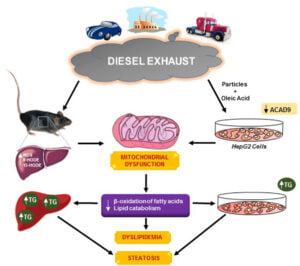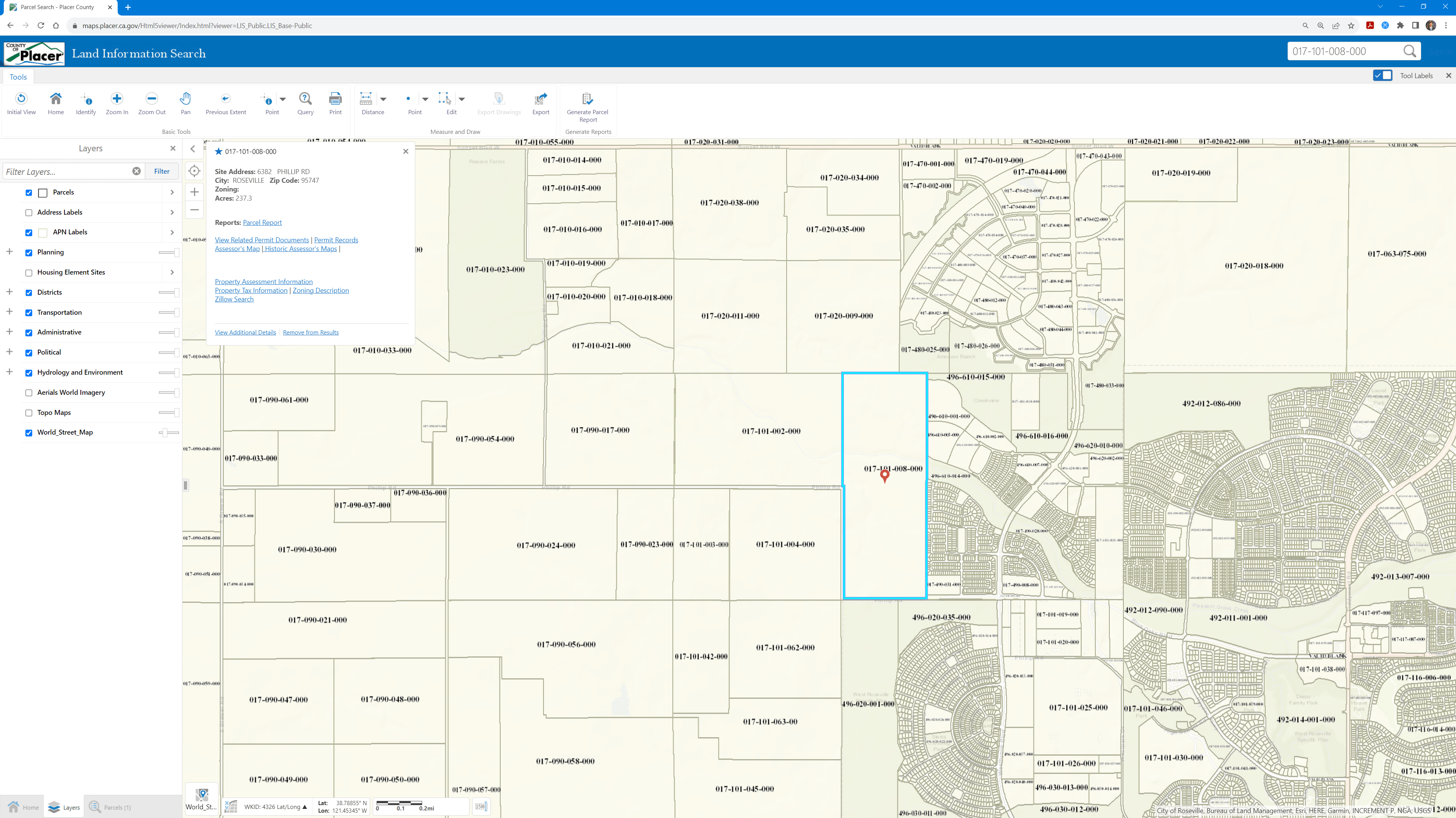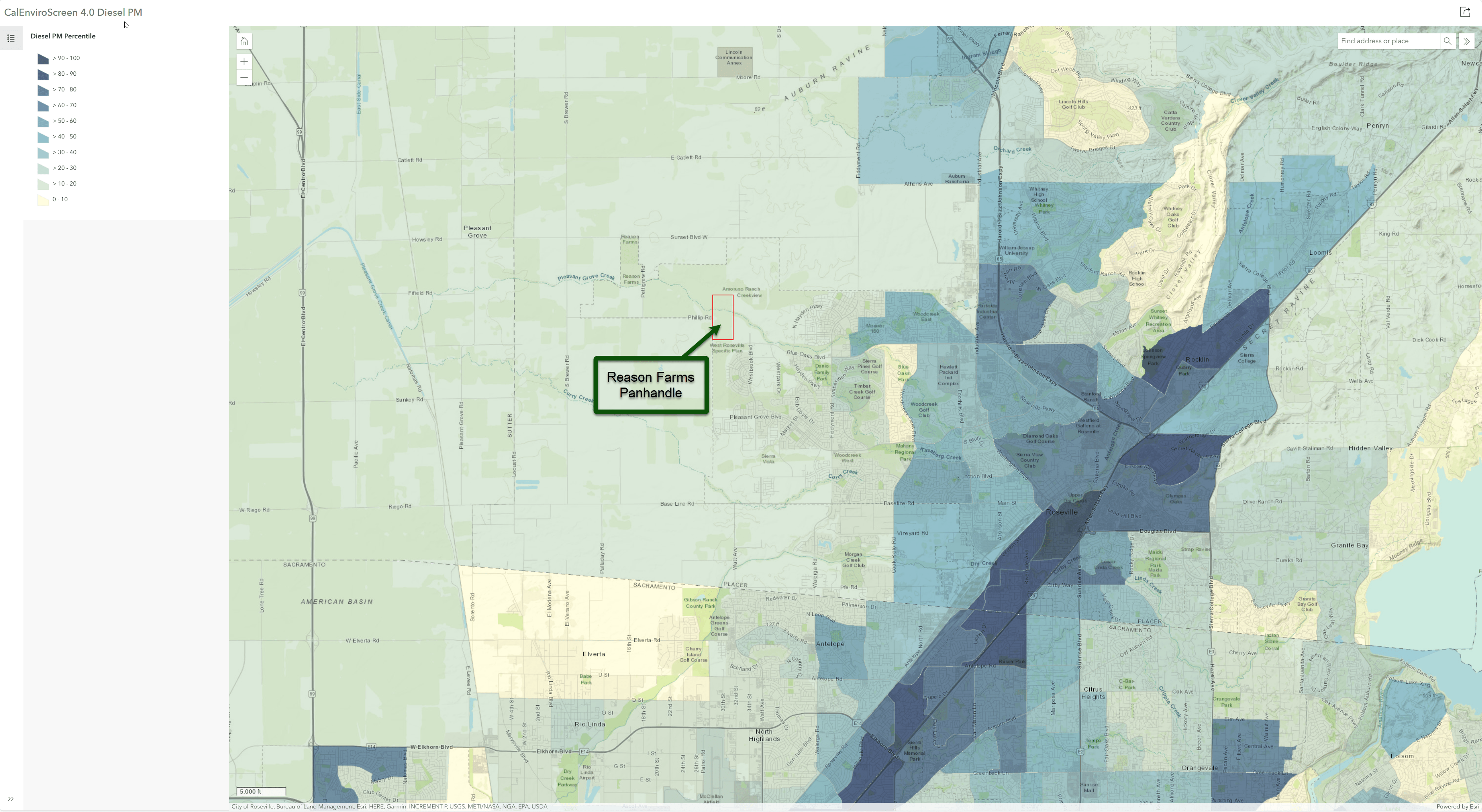Author: Advocate
Absurd location for fatally flawed industrial project.
Phillip Road Site is an absurd location for fatally flawed industrial project.

Save Reason Farms is pursuing actions to stop the proposed industrial rezoning of the Roseville-owned property located at 6382 Phillip Road in Roseville, California. The Phillip Road Site parcel is also known as the Reason Farms panhandle. The Phillip Road Site is an absurd location for this fatally flawed industrial project.
If City Councilmembers were to rezone the Phillip Road Site as industrial, quality of life would become very bad for Roseville residents. The City of Roseville General Plan 2035 would have to be amended in order to rezone this Public/Quasi-public parcel of farmland to industrial. Rezoning would be very bad.
Major problems with rezoning from farmland to industrial include but are not limited to the following:
- Rezoning from farmland to industrial the Phillip Road Site would harm Roseville residents, adversely impact health and safety.
- It is estimated that Sensitive Groups including 6,732 students and 8,075 seniors living in the area would be impacted, in addition to day care centers and public recreation facilities.
- Rezoning this parcel would financially benefit Panattoni Development Company, which is a privately held real estate developer specializing in industrial real estate and warehouses.
- In an August 15, 2023 email to the Economic Development Director for the City of Roseville from the California Housing and Community Development (HCD), HCD stated, “it appears the proposed disposition of the site may be in conflict with the SLA”, referring to the California Surplus Land Act.
On March 3, 2021, Roseville Councilmembers passed Resolution No. 21-080 that authorized the City Manager (Dominick Casey) to execute an Option and Purchase and Sale Agreement (“Purchase Agreement”).
This Purchase Agreement is now the focus of intense public scrutiny and there is a groundswell of civic action to terminate it.
This Purchase Agreement pertains to the Roseville-owned Phillip Road Site property located at 6382 Phillip Road (also referred to as the Reason Farms panhandle).
- The subject property is currently zoned Public/Quasi-Public.
- Nearby schools, day care centers, elderly care facilities, and public recreation facilities.
- The Purchase Agreement is contingent on the purchaser (Panattoni) requesting that the property be rezoned to an industrial designation.
- As stated in the Purchase Agreement, the property includes “all of Seller’s right, title and interest in any assignable licenses, permits, mineral rights, water rights or shares, easements, rights-of way…”
- Pleasant Grove Creek contains water that flows across the Phillip Road Site.
- Panattoni was required to deposit just $50,000 with the title company to lock in an exclusive option contract to purchase the Phillip Road Site property at 6382 Phillip Road.
- The first phase of 35 acres is expected to result in $1,243,165 ($34,519/acre).
RECOMMENDED ACTIONS FOR ROSEVILLE COUNCILMEMBERS
(a) Approve a City Council motion to terminate the contract between the Panattoni Development Corporation (PDC Sacramento LPIV, LLC) and the City relating to a proposed industrial park on the Phillip Road Site (APN 017-101-008-000), which is also known as the Reason Farms panhandle parcel; and
(b) Approve a City Council motion to keep the Phillip Road Site parcel (APN 017-101-008-000) zoned as Public/Quasi-Public farmland until such time that other developers’ ideas can fully be evaluated by the City’s Councilmembers and its planning team; and
(c) Consider for the Phillip Road Site parcel only non-industrial land uses that will keep Roseville residents safe, healthy, and happy.
According to the Attorney General for the State of California, Department of Justice, City of Roseville should heed this guidance for proper land use:
“Establish industrial districts NEAR MAJOR HIGHWAY AND RAIL CORRIDORS, but AWAY FROM SENSITIVE RECEPTORS”
Rob Bonta, Attorney General (September 2022)“Sensitive Receptors” include hospitals, schools, day care centers, elderly care facilities, public recreation facilities, and other such locations. Sensitive receptors are children, elderly, asmatics and others whose are at a heightened risk of negative health outcomes due to exposure to air pollution. The locations where these sensitive receptors congregate are considered sensitive receptor locations. Sensitive Receptor locations may include hospitals, schools, and day care centers, and such other locations as the air district board or California Air Resources Board (CARB) may determine (California Health and Safety Code § 42705.5(a)(5)).
The Phillip Road Site parcel is too FAR FROM MAJOR HIGHWAY AND RAIL CORRIDORS and DANGEROUSLY CLOSE TO SENSITIVE RECEPTORS.
Under California state law: “[E]nvironmental justice” means the fair treatment of people of all races, cultures, and incomes with respect to the development, adoption, implementation, and enforcement of environmental laws, regulations, and policies. (Gov. Code, § 65040.12, subd. (e)).
“[I]mprudent warehouse development can harm local communities and the environment. Among other pollutants, diesel trucks visiting warehouses emit nitrogen oxide (NOx) — a primary precursor to smog formation and a significant factor in the development of respiratory problems like asthma, bronchitis, and lung irritation—and diesel particulate matter (a subset of fine particular matter that is smaller than 2.5 micrometers) — a contributor to cancer, heart disease, respiratory illnesses, and premature death. Trucks and on-site loading activities can also be loud, bringing disruptive noise levels during 24/7 operation that can cause hearing damage after prolonged exposure. The hundreds, and sometimes thousands, of daily truck and passenger car trips that warehouses generate contribute to traffic jams, deterioration of road surfaces, and traffic accidents.”
For best practices about warehouse siting and design considerations and air quality and greenhouse gas emissions, see CA DOJ’s Warehouse Projects: Best Practices and Mitigation Measures to Comply with the California Environmental Quality Act (CEQA)
Phillip Road Site is an absurd location for this fatally flawed industrial project.
The subject Phillip Road Site (aka Reason Farms Panhandle parcel) is an inappropriate location for warehousing and distribution, or any other industrial use.
City of Roseville currently has enough industrial space. Smart Growth principles require that the City of Roseville not rezone as industrial the Phillip Road Site (aka Reason Farms Panhandle parcel).
Plenty of Available Industrial Space in Roseville
- Roseville residents think the City should make use of the 11+ million square feet of locally available industrial real estate before considering the creation of new industrial space.
- Any new industrial space would need to be sited far away from hospitals, schools, day care centers, elderly care facilities, public recreation facilities, and other such locations.
- The Property at 6382 Phillip Road (aka Phillip Road Site, aka Reason Farms Panhandle) is currently zoned as Public/Quasi-Public and it is an inappropriate location for industrial development.
| Location | Square Feet |
|---|---|
| Placer Commerce Center Foothills Blvd North & South of Athens Avenue | 6,400,000 SF |
| Williams Health & Technology Center 1451 & 1431 Blue Oaks Blvd / 9100 Foothills Blvd | 900,000 SF |
| Foothills Station Foothills Blvd & Pleasant Grove Blvd | 290,000 SF |
| Crossdock Distribution Building 8891 Foothills Blvd | 154,000 SF |
| Roseville Innovation Center - R1, R3, R5 8000 - 8050 Foothills Blvd (Hewlett Packard) | 220,000+ SF |
| Warehousing / Distribution 8020 Foothills Blvd | 155,000 SF |
| Panattoni Industrial Park 7601 Foothills Blvd (Phase 1) | 149,900 SF |
| Hewlett Packard Campus 9000 Foothills Blvd | 40,994 SF |
| 4-Star Industrial Space 10050 Foothills Blvd | 35,000 SF |
| Blue Oaks Tech Center 9083 - 9089 | 37,980 SF |
| 4-Star Industrial Space 8875 Washington Blvd | 100,800 SF |
| Panattoni Industrial Park 7601 Foothills Blvd (Future Phases Approved at this Location) | 1,079,465 SF |
| Foothills Commerce Center Winding Creek Rd @ Foothills Blvd (Future Phases Approved at this Location) | 1,000,000 SF |
| Roseville 80 (Future Phases Approved at this Location) | 622,250 SF |
| Grand Total | 11,144,395 SF |
City’s Land Use Map shows the substantial existing amount of industrial properties in the North Industrial Zone. According to the City of Roseville General Plan 2035, industrial zones are identified with the acronyms LI, IND, T/BP, and TS. Industrial properties are properly situated next to existing highways and train corridors.
The Property at 6382 Phillip Road (aka the Phillip Road Site, aka Reason Farms Panhandle parcel) can be pinpointed on a map using APN 017-101-008-000. This Property is currently zoned as Public/Quasi-Public (PQP). For the reasons discussed above, it would be environmentally unjust and utterly inappropriate if the City Councilmembers were to rezone as industrial this parcel of Roseville land.
Source: https://maps.placer.ca.gov/Html5viewer/Index.html?viewer=LIS_Public.LIS_Base-Public
Horrible Pollution from Diesel Trucks
Horrible pollution from diesel trucks

What is diesel exhaust?
Diesel exhaust is produced when an engine burns diesel fuel. It is a complex mixture of thousands of gases and fine particles (commonly known as soot) that contains more than 40 toxic air contaminants. These include many known or suspected cancer-causing substances, such as benzene, arsenic and formaldehyde. It also contains other harmful pollutants, including nitrogen oxides (a component of urban smog).
Air Pollution
Air pollution is associated with increased cardiovascular morbidity and mortality (i.e. death), as well as dyslipidemia and metabolic syndrome.
-
Diesel exhaust induces mitochondrial dysfunction, hyperlipidemia, hypertriglyceridemia, hypercholesterolemia, and liver steatosis.
-
Diesel exhaust alters lipid and carbohydrate metabolism.
- Development of hepatic steatosis is likely due to mitochondrial dysfunction in the liver.
Reference: Arteriosclerosis, Thrombosis, and Vascular Biology, Vol. 39, No. 9, Diesel Exhaust Induces Mitochondrial Dysfunction, Hyperlipidemia, and Liver Steatosis
How are people exposed to diesel exhaust?
Diesel exhaust particles and gases are suspended in the air, so exposure to this pollutant occurs whenever a person breathes air that contains these substances. The prevalence of diesel-powered engines makes it almost impossible to avoid exposure to diesel exhaust or its byproducts, regardless of whether you live in a rural or urban setting. However, people living and working in urban and industrial areas are more likely to be exposed to this pollutant. Those spending time on or near roads and freeways, truck loading and unloading operations, operating diesel-powered machinery or Health effects of Diesel Exhaust. A fact sheet by Cal/EPA’s Office of Environmental Health Hazard Assessment and The American Lung Association of California working near diesel equipment face exposure to higher levels of diesel exhaust and face higher health risks.
What are the health effects of diesel exhaust?
As we breathe, the toxic gases and small particles of diesel exhaust are drawn into the lungs. The microscopic particles in diesel exhaust are less than one-fifth the thickness of a human hair and are small enough to penetrate deep into the lungs, where they contribute to a range of health problems.
Diesel exhaust and many individual substances contained in it (including arsenic, benzene, formaldehyde and nickel) have the potential to contribute to mutations in cells that can lead to cancer. In fact, long-term exposure to diesel increases the risk of exhaust particles poses the highest cancer risk of any toxic air contaminant evaluated by the California Environmental Protection Agency’s Office of Environmental Health Hazard Assessment (OEHHA).
The California Air Resources Board (ARB) estimates that about 70 percent of the cancer risk that the average Californian faces from breathing toxic air pollutants stems from diesel exhaust particles. In its comprehensive assessment of diesel exhaust, OEHHA analyzed more than 30 studies of people who worked around diesel equipment, including truck drivers, railroad workers and equipment operators. The studies showed these workers were more likely to develop lung cancer than workers who were not exposed to diesel emissions. These studies provide strong evidence that long-term occupational exposure to diesel exhaust increases the risk of lung cancer. Using information from OEHHA’s assessment, ARB estimates that diesel-particle levels measured in California’s air in 2000 could cause 540 “excess” cancers (beyond what would occur if there were no diesel particles in the air) in a population of 1 million people over a 70-year lifetime. Other researchers and scientific organizations, including the National Institute for Occupational Safety and Health, have calculated cancer risks from diesel exhaust that are similar to those developed by OEHHA and ARB.
Diesel Particulate Matter
According to the California Office of Environmental Health Hazard Assessment (OEHHA):
“Exhaust from trucks, buses, trains, ships, and other equipment with diesel engines contains a mixture of gases and solid particles. These solid particles are known as diesel particulate matter (diesel PM). Diesel PM contains hundreds of different chemicals. Many of these are harmful to health. The highest levels of diesel PM are near ports, rail yards and freeways. People are exposed to diesel PM from breathing air containing diesel exhaust.”
- People living and working in cities and industrial areas and near heavy truck or train traffic are most likely to come in contact with diesel PM.
- The very small particles of diesel PM can reach deep into the lung, where they can contribute to a range of health problems. These include irritation to the eyes, throat and nose, heart and lung disease, and lung cancer.
- Children and the elderly are especially vulnerable to the effects of diesel PM.
How is diesel particulate matter measured in CalEnviroScreen 4.0?
- The California Air Resources Board (CARB) collects estimates of diesel PM emissions from many sources.
- The indicator uses CARB data on emissions from on-road (trucks and buses) and off-road (ships and trains, for example) sources.
- Diesel emissions are available at a 1x1km grid statewide. The gridded emissions are converted to census tracts.
- Adjustments to diesel PM emissions from idling trucks in Mexico at the U.S. border crossings were also accounted for.
A complete description of the Diesel PM indicator can be found in the CalEnviroScreen 4.0 report.
Exposure to diesel exhaust can have immediate health effects. Diesel exhaust can irritate the eyes, nose, throat and lungs, and it can cause coughs, headaches, light-headedness and nausea. In studies with human volunteers, diesel exhaust particles made people with allergies more susceptible to the materials to which they are allergic, such as dust and pollen. Exposure to diesel exhaust also causes inflammation in the lungs, which may aggravate chronic respiratory symptoms and increase the frequency or intensity of asthma attacks.
Exposure to diesel exhaust also causes inflammation in the lungs, which may aggravate chronic respiratory symptoms and increase the frequency or intensity of asthma attacks. Diesel engines are a major source of fine-particle pollution. The elderly and people with emphysema, asthma, and chronic heart and lung disease are especially sensitive to fine-particle pollution. Numerous studies have linked elevated particle levels in the air to increased hospital admissions, emergency room visits, asthma attacks and premature deaths among those suffering from respiratory problems. Because children’s lungs and respiratory systems are still developing, they are also more susceptible than healthy adults to fine particles. Exposure to fine particles is associated with increased frequency of childhood illnesses and can also reduce lung function in children.
Diesel engines produce nitrogen oxides — an air pollutant. Nitrogen oxides can damage lung tissue, lower the body’s resistance to respiratory infection and worsen chronic lung diseases, such as asthma. They also react with other pollutants in the atmosphere to form ozone, a major component of smog.
Source: California Office of Environmental Health Hazard Assessment
Source: CalEnviroScreen 4.0 Diesel PM
For the excellent reasons set forth above, Roseville residents aim to protect and preserve the Phillip Road Site.





